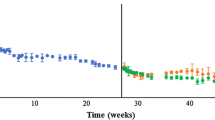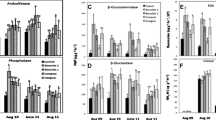Abstract
This greenhouse study examined the use of organic and inorganic soil amendments in waste rock material from the former Questa Molybdenum Mine in northern New Mexico to promote beneficial soil properties. Waste rock material was amended with 11 soil amendment treatments that included municipal composted biosolids, Biosol®, inorganic fertilizer, and two controls (pure waste rock and sand). Elymus trachycaulus and Robinia neomexicana growth performance and plant chemistry were assessed across all treatments over a period of 99 and 141 days, respectively. Even though waste rock material had more than 200 times the molybdenum concentration of native soils, adverse effects were not observed for either species. The two main limiting factors in this study were soil nutritional status and soil water retention. The biosolid amendment was found to provide the greatest buffer against these limiting factors due to significant increases in both nutrition and soil water retention. As a result, both species responded with the highest levels of biomass production and the least amount of required water demands. Use of organic amendments such as biosolids, even though short lived in the soil, may provide plants the necessary growth stimulus to become more resilient to the harsh conditions found on many mine reclamation sites.





Similar content being viewed by others
References
Alberty RA (2005) Thermodynamics of the mechanism of the nitrogenase reaction. Biophys Chem 114:115–120
Barbarick K, Doxtader K, Redente EF, Brobst R (2004) Biosolids effects on microbial activity in shrubland and grassland soils. Soil Sci 169(3):176–187
Berg WA, Guillaume M, Herron JT (1986) Effect of fertility treatments and mulches on revegetation of alpine disturbances. In: Schuster MA, Zuck RA (eds) Proc.: high altitude revegetation workshop no. 7. Colorado State Univ. Info. Ser. 58. Colorado State Univ., Fort Collins, pp 142–152
Birchler T, Haase DL, Rose R (1996) Use of vector diagrams for the interpretation of nutrient response in conifer seedlings. In: Landis TD, South DB, tech. coords (eds) National Proceedings, Forest and conservation nursery associations. Gen. Tech. Rep. PNW-GTR-389. U.S. Department of Agriculture, Forest Service, Pacific Northwest Research Station, Portland, OR, pp 246–247
Bittner F (2014) Molybdenum metabolism in plants and crosstalk to iron. Front Plant Sci 5:1–6
Bremner IM, Mulvaney CS (1982) Nitrogen - total. In: Page AL (ed) Methods of soil analysis part 2, 2nd edn. Agronomy Monograph 9. American Society of Agronomy and Soil Science Society of America, Madison, WI, pp 595–624
Brown S, Henry C, Chaney R, Compton H, DeVolder P (2003) Using municipal biosolids in combination with other residuals to restore metal-contaminated mining areas. Plant Soil 249:203–215
GEI Consultants Inc (2008) Spring gulch rock pile soil molybdenum toxicity testing. Report submitted to Chevron Mining, Inc. July, 2008
Goldberg S, Forster HS (1998) Factors affecting molybdenum adsorption by soils and minerals. Soil Sci 163(2):109–114
Hale KL, McGrath SP, Lombi E, Stack SM, Terry N, Pickering IJ, George GN, Pilon-Smts EAH (2001) Molybdenum sequestration in Brassica species. A role for anthocyanins? Plant Physiol 126:1391–1402
Hecht-Buchholz C (1973) Molybdänverteilung und -verträglichkeit bei Tomate, Sonnenblume und Bohne. Z Pflanzenernaehr Bodenk 136:110–119
Jurado P, Wester DB (2001) Effects of biosolids on tobosagrass growth in the Chihuahuan desert. J Rang Manage 54:89–95
Kabata-Pendias A (2011) Trace elements in soils and plants. CRC Press, Boca Raton, FL
Kaiser BN, Gridley KL, Brady JN, Phillips T, Tyerman SD (2005) The role of molybdenym in agricultural plant production. Ann Bot 96(5):745–754
Knudsen D, Peterson GA, Pratt PF (1982) Lithium, sodium, and potassium. In: Page AL (ed) Methods of soil analysis part 2, 2nd edn. Agronomy Monograph 9. American Society of Agronomy and Soil Science Society of America, Madison, WI, pp 225–245
Kopsell DA, Kopsell DE, Hamlin RL (2015) Chapter 13: molybdenum. In: Handbook of plant nutrition, second edition. Edited by Allen V Barker and David J Pilbeam
Marschner H (1995) Mineral nutrition of higher plants, 2nd edn 889pp. Academic Press, London
McAuliffe C, Chamblee DS, Uribe-Arango H, Woodhouse WW (1958) Influence of inorganic nitrogen on nitrogen fixation by legumes as revealed by N15. Agron J 50(6):334–337
Medlin E, Drexler JW (1995) Development of an in vitro technique for the determination of bioavailability from metal-bearing solids. International Conference on the Biogeochemistry of Trace Elements, Paris, France, 217 p
Neunhauserer C, Berreck M, Insam H (2001) Remediation of soils contaminated with molybdenum using soil amendments and phytoremediation. Water Air Soil Poll 128:85–96
Olsen SR, Sommers LE (1982) Phosphorus. In: Page AL (ed) Methods of soil analysis part 2, 2nd edn. Agronomy Monograph 9. American Society of Agronomy and Soil Science Society of America, Madison, WI, pp 403–427
Page AL (ed) (1982) Methods of soil analysis part 2, 2nd Edition. American Society of Agronomy and Soil Science Society of America, Madison, WI
Paschke MW, Topper K, Brobst RB, Redente EF (2005) Long-term effects of biosolids on revegetation of disturbed sagebrush steppe in Northwestern Colorado. Restor Ecol 13:545–551
Pichtel JR (1994) Comparison of amendments and management practices for long-term reclamation of abandoned mine lands. J Environ Qual 23:766–772
Pierce BL, Redente EF, Barbarick KA, Brobst RB, Hegeman P (1998) Plant biomass and elemental changes in shrubland forages following biosolids application. J Environ Qual 27:789–794
Pond AP, White SA, Milczarek M, Thompson TL (2005) Accelerated weathering of biosolid-amended copper mine tailings. J Environ Qual 34:1293–1301
Rieder JP, Redente EF, Richard CE, Paschke MW (2013) An approach to restoration of acidic waste rock at a high elevation gold mine in Colorado USA. Ecol Res 31:283–294
Sakellariou-Makrantonaki MA, Dimakas DS (2013) Effects of biosolids application on sweet sorghum biomass, water use efficiency and ethanol production. Fresenius Environ Bull 22(3):914–921
Shacklette HT, Boerngen JG (1984) Element concentrations in soils and other surficial materials of the conterminous United States: US Geological Survey Professional Paper 1270, 105 p
Soil and Plant Analysis Council Inc. (1999) Determination of organic matter by loss-on-ignition. Soil analysis handbook of reference methods. CRC Press LLC, Boca Raton, FL, pp 178–179
Sposito G (1989) The chemistry of soils. Oxford University Press, New York, 277 p
USEPA (1989) USEPA method study 37 SW-846 method 3050 acid digestion of sediments, Sludges, and soils. USEPA Enviromental Monitoring Systems Laboratory, Cincinnati, OH
USEPA (1999) Test methods for evaluating solid waste: physical/chemical methods. Third Editon. Final update III-A. EPASW-846.3-3a. Government Printing Office, Washington, D.C.
Wichard T, Mishra B, Myneni SCB, Bellenger JP, Kraepiel AML (2009) Storage and bioavailability of molybdenum in soils increased by organic matter complexation. Nat Geosci 9(2):625–629
Winter-Sydnor ME, Redente EF (2002) Reclamation of high-elevation acidic mine waste with organic amendments and topsoil. J Environ Qual 31:1528–1537
Acknowledgements
Funding support for this research was provided by Chevron Mining, Inc. Additional logistical and analytical support was provided by Arcadis US, Inc. The authors extend special acknowledgments to T. Parsons, R. Heyduck, B. Espinoza, J. Trujillo, and L. Gallegos.
Author’s contributions
OB, ER, and CL conceived and designed the research. OB performed the experiments. OB analyzed the data. OB, ER, and CL contributed reagents/materials/analysis tools. OB, ER, and CL wrote and edited the manuscript.
Author information
Authors and Affiliations
Corresponding author
Additional information
Responsible editor: Philippe Garrigues
Implications
• Composted biosolids (municipal waste) was found to be an effective soil amendment in establishing plants on mine waste rock material. Biosolids help to buffer against limited precipitation and low native soil nutrients through increasing both soil water retention and plant-available nutrients.
• Plant toxicity was not observed in either Elymus trachycaulus or Elymus trachycaulus when planted in waste rock material that contained over 200 times the molybdenum concentrations of native soils. Additionally, uptake and bioaccumulation of molybdenum in both plant species did not reach levels considered toxic to potential herbivores.
• Adding inorganic nutrients with limited organic material to retain water will result in increased growth as well as water demands, which is not ideal for this harsh, dry site conditions.
Rights and permissions
About this article
Cite this article
Burney, O.T., Redente, E.F. & Lambert, C.E. Plant growth in amended molybdenum mine waste rock. Environ Sci Pollut Res 24, 11215–11227 (2017). https://doi.org/10.1007/s11356-017-8716-z
Received:
Accepted:
Published:
Issue Date:
DOI: https://doi.org/10.1007/s11356-017-8716-z




